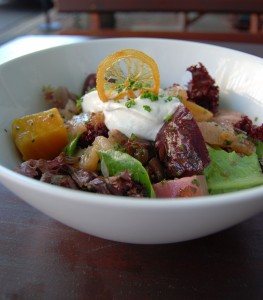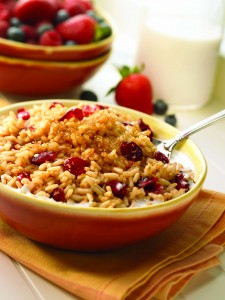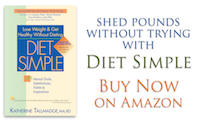Eating to Save the Planet
- At May 14, 2012
- By Katherine
- In Articles, News
 3
3
Katherine explaining “Farmers Markets: Good For You, Good For The Environment” Watch on CNN
For those of you who want to make a contribution toward saving the planet, you may want to consider changing what you eat. One simple way to do that? Buy locally and seasonally at your Farmers Market.
What you eat profoundly affects not only your health, but the environment, too. This is important news because when it comes to environmental issues and halting global warming, many of us feel overwhelmed and helpless. So it’s amazing that something as simple as making better food choices can reduce global warming by lowering greenhouse gases, saving land, and conserving diminishing water and energy supplies.
Your protein choice will make the most significant difference on the environment (and your health). Producing meat requires six to seventeen times more land than growing vegetable protein, 26 times more water. And producing vegetables is up to 50 times more energy efficient than meat production, according to a study in the American Journal of Clinical Nutrition.
Eating vegetable protein will also save your health. Decades of research has found that plants contain compounds (phytochemicals) with potent powers of healing. People who eat a plant-based diet are leaner, have less cancer, heart disease and diabetes.
But when eating more fruits and vegetables, it’s important to consider how and where they’re grown. Environmental resource conservation is reduced if food is transported long distances and grown in large industrial farms which specialize in only one or a few foods. Locally, organically produced food saves water, energy and encourages a region’s unique varieties of fruits and vegetables. Heirloom varieties, for example, have been passed down through generations, have natural resistance to pests, disease and are better able to tolerate local conditions without too much exra energy, pesticides or water.
How you can protect the environment through your food choices:
* Buy seasonally and locally at farm stands and farmers’ markets,
* Eat a plant-based diet,
* Reduce meat consumption,
* Use heirloom varieties, whenever possible,
* Buy organic whenever possible.
This article was excerpted from: The Journal of the American Dietetic Association 2007; 107: 1033 – 1043 “Position of the American Dietetic Association: Food and Nutrition Professionals Can Implement Practices to Conserve Natural Resources and Support Ecological Sustainability”
Do You Need Gluten-Free?
- At February 16, 2012
- By Katherine
- In Articles, News
 5
5
A jug of wine, NO loaf of bread, and thou?
See me explain how a gluten-free diet may do more harm than good on ABC-7
This article appeared in The Huffington Post
Hear me – and three other experts – discuss “The Gluten-Free Craze” on National Public Radio’s The Diane Rehm Show.
It’s all the rage right now; in fact, you may be thinking of going on a gluten-free diet. Before you do, here are some things to think about: First, you are likely to miss out on critical nutrients and health benefits only gained with gluten-containing whole grains.
Second, a gluten-free diet is a therapeutic diet for those with debilitating celiac disease, a serious auto-immune disorder which virtually destroys the intestinal tract. But celiac only affects about 1% of the population.
Third, the danger of self-diagnosing and taking gluten out of your diet prematurely is that you will would never be able to get an accurate diagnosis of your symptoms. An intestinal biopsy is the only way to detect celiac definitively.
People try a gluten-free diet because they are overweight, feel tired, bloated, and/or depressed, and find reducing gluten correlates with feeling better or losing weight. But that is more likely because they’ve cut out excess calories found in many flour-based snack foods and they mistakenly attribute feeling better to taking out the gluten. So, before you rush into a gluten-free diet, why not try something simple, say, an apple… or exercise? Or would you prefer a life of no bread, pasta or birthday cakes? It’s a tough row to hoe, and I’m here if you need me, as studies have found gluten-free diets can be seriously nutrient-deficient, low in fiber, iron, folate, niacin, thiamine, riboflavin, calcium, B12, phosphorus, and zinc. That’s because so many “gluten-free” products are made with refined, unenriched grains and starches, which contain plenty of calories, but very few vitamins and minerals.
The new gluten-free industry is making millions from Americans’ desperation to feel better. There has been an explosion of gluten-free junk foods, and I hope you don’t become a victim.
But I have great news… many clients have thought they might need a gluten-free diet, but when we worked together at improving their nutrition and life balance, symptoms vanished! Perhaps that could be you?
If you take the following steps and find you do need a gluten-free diet, it can fill all your nutritional requirements, but only if done CAREFULLY…
Do You Need A Gluten-Free Diet? A Step-by-Step Guide
1. Have a complete check-up with your family physician,
2. Consult with appropriate specialists, such as an allergist for wheat allergy and a gastroenterologist for celiac or another GI disease,
A. If you have a wheat allergy, you must avoid wheat, but you do not have to avoid gluten from other grains,
B. If you have celiac disease, you must avoid gluten – even the tiniest amounts (you must be eating gluten for the diagnosis to be made),
3. If you do not have a wheat allergy or celiac, visit a registered dietitian to verify that you are eating a balanced diet with plenty of nutrient-dense, naturally fiber-rich foods and adequate physical activity. A healthy diet and lifestyle reduces negative gastrointestinal symptoms, inflammation, boosts the immune system, improves brain function, reduces depression, and anxiety. If you are overweight, lose weight, as body fat can be toxic and produces hormones and pro-inflammatory chemicals which regulate metabolism, the immune system, inflammation, and the progression of artery hardening, so that when you have less body fat, you get many biological benefits, and feel better,
4. If symptoms persist, though in most cases they do not, you may be one of the rare people who are “gluten sensitive,” though hopefully not, as it’s a tough life. To confirm the diagnosis, and if a gluten-free diet is absolutely necessary for you – even though a gastroenterologist has verified you do not have celiac disease – visit your gastroenterologist, or the University of Maryland’s “Center for Celiac Research,” where they specialize in, among other things, detecting “gluten sensitivity,” which may be a newly identified disorder.
What is Gluten?
Gluten is a protein in wheat and some other grains, such as rye and barley. A gluten experiment in Food Science at the University of Maryland left a lasting impression on me about the function and importance of gluten. I kneaded bread dough under flowing water. As I kneaded the dough, the starch slowly washed away. What remained was a rubbery mass – the gluten – the protein in wheat which gives bread its structure.
Gluten-Containing Foods
Barley, Bulgur, Cereal Binding, Couscous, Durum, Einkorn, Emmer, Filler, Farro, Graham Flour, Kamut, Malt, Malt Extract, Malt Flavoring, Malt Syrup, Oats which are not labeled “Gluten-Free” because they have been contaminated by gluten in the field or in the processing plant, Rye, Semolina, Spelt, Triticale, Wheat, Wheat Bran, Wheat Germ, Wheat Starch, and others…
Naturally Gluten-Free Whole Grains
Brown Rice, Whole Corn, Gluten-Free Oats, Millet, Teff, Sorghum, Wild Rice, Buckwheat, Amaranth, and Quinoa.
Wheat Allergy
WA is an adverse immunologic reaction to wheat proteins, a classic food allergy affecting the skin, gastrointestinal tract or respiratory tract.*
Celiac Disease
CD is an immune-mediated enteropathy (intestinal disease) triggered by the ingestion of gluten in susceptible individuals. The onset of symptoms is usually gradual and characterized by a time lag of months or years after gluten introduction.*
Gluten Sensitivity
When both allergic (WA) and autoimmune mechanisms (CD) have been ruled out (diagnosis by exclusion criteria), individuals who experience distress when ingesting gluten may be considered as having GS.*
*“Spectrum of gluten-related disorders: consensus on new nomenclature and classification,” BMC Medicine 2012, 10:13 doi:10.1186/1741-7015-10-13; Sapone, Bai, Ciacci, Dolinsek, Green, Hadjivassiliou, Kaukinen, Rostami, Sander, Schumann, Ullrich, Villalta, Volta, Catassi, Fasano.
It is critical that you are examined by a gastroenterologist before switching to a Gluten-Free diet.
Why? Once you eliminate gluten, it is virtually impossible to diagnose celiac, and the diagnosis of celiac, an extremely serious auto-immune disorder, should be your primary concern.
My Favorite Gluten-Free Guides
“Gluten-Free Diet: A Comprehensive Resource Guide” by Shelley Case, R.D.*
“Easy Gluten-Free” by Tricia Thompson, M.S., R.D. and Marlisa Brown, M.S., R.D.*
“Gluten-Free, Hassle Free” by Marlisa Brown, R.D., C.D.E.*
*Anyone giving gluten-free dietary advice should be a registered dietitian, and have the “R.D.” after their name.
Don’t forget, Diet Simple is filled with recipes, including some marked “Gluten-Free!”
Hear me – and three other experts – discuss
“The Gluten-Free Craze” on National Public Radio’s The Diane Rehm Show.
See me explain how a gluten-free diet may do more harm than good on ABC-7
New Study Finds Certain Foods Lead to Living Longer
- At December 22, 2010
- By Katherine
- In Articles, News
 0
0
 Eating Healthier Means Living Longer
Eating Healthier Means Living Longer
According to New Study in the Journal of the American Dietetic Association
Researchers found that diets favoring certain foods were associated with reduced mortality.
The leading causes of death have shifted from infectious diseases to chronic diseases such as cardiovascular disease and cancer. These illnesses may be affected by diet. In a study published in the January 2011 issue of the Journal of the American Dietetic Association, researchers found that diets favoring certain foods were associated with reduced mortality. Scientists investigated empirical data regarding the associations of dietary patterns with mortality through analysis of the eating patterns of over 2500 adults between the ages of 70 and 79 over a ten-year period.
By 2030, an estimated 973 million adults will be aged 65 or older worldwide. The objective of this study was to determine the dietary patterns of a large and diverse group of older adults, and to explore associations of these dietary patterns with survival over a 10-year period. A secondary goal was to evaluate participants’ quality of life and nutritional status according to their dietary patterns.
By determining the consumption frequency of 108 different food items, researchers were able to group the participants into six different clusters according to predominant food choices:
- “Healthy foods” (374 participants)
- “High-fat dairy products” (332)
- “Meat, fried foods, and alcohol” (693)
- “Breakfast cereal” (386)
- “Refined grains” (458)
- “Sweets and desserts” (339).
The “Healthy foods” cluster was characterized by relatively higher intake of low-fat dairy products, fruit, whole grains, poultry, fish, and vegetables, and lower consumption of meat, fried foods, sweets, high-calorie drinks, and added fat. The “High fat dairy products” cluster had higher intake of foods such as ice cream, cheese, and 2% and whole milk and yogurt, and lower intake of poultry, low-fat dairy products, rice, and pasta.
The study was unique in that it evaluated participants’ quality of life and nutritional status, through detailed biochemical measures, according to their dietary patterns. After controlling for gender, age, race, clinical site, education, physical activity, smoking, and total calorie intake, the “High-fat dairy products” cluster had a 40% higher risk of mortality than the “Healthy foods” cluster. The “Sweets and desserts” cluster had a 37% higher risk. No significant differences in risk of mortality were seen between the “Healthy foods” cluster and the “Breakfast cereal” or “Refined grains” clusters.
Photo by Polly Wiedmaier











